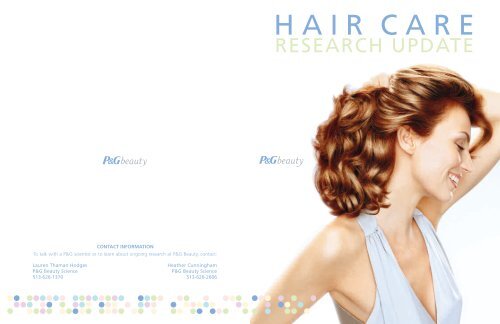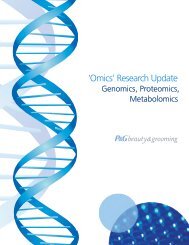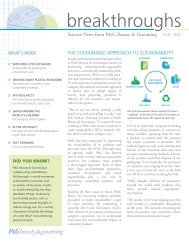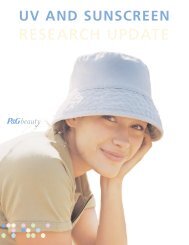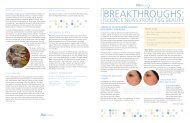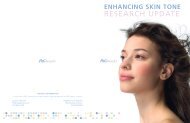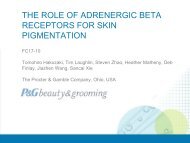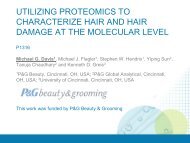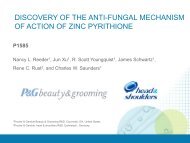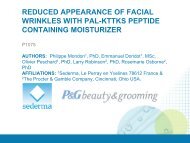HAIR CARE - P&G Beauty & Grooming
HAIR CARE - P&G Beauty & Grooming
HAIR CARE - P&G Beauty & Grooming
You also want an ePaper? Increase the reach of your titles
YUMPU automatically turns print PDFs into web optimized ePapers that Google loves.
<strong>HAIR</strong> <strong>CARE</strong><br />
RESEARCH UPDATE<br />
CONTACT INFORMATION<br />
To talk with a P&G scientist or to learn about ongoing research at P&G <strong>Beauty</strong>, contact:<br />
Lauren Thaman Hodges<br />
P&G <strong>Beauty</strong> Science<br />
513-626-1370<br />
Heather Cunningham<br />
P&G <strong>Beauty</strong> Science<br />
513-626-2606
TABLE OF CONTENTS<br />
DEFINING ISSUES<br />
Introduction 1<br />
Biological Facts<br />
Getting to the Root of the Problem 1<br />
Growing Concerns 2<br />
Advances In Science<br />
It Started With Shampoo 3<br />
Deposition Technology Delivers 4<br />
Lab Notes<br />
Stranded 5<br />
Repaired 5<br />
Emotional Attitudes & Behaviors<br />
Hair Hurts and Heals 5<br />
WHAT WORKS<br />
New <strong>Beauty</strong> Intelligence<br />
Amino Acid Technology Rebuilds<br />
Hair From the Inside 6<br />
Chroma Technology Intensifies<br />
Color Perception 7<br />
Complete Regimes Improve Efficacy 8<br />
Did You Know?<br />
Weighing-in On Hair, and Its Care 9<br />
WHAT’S COMING<br />
Promising New Areas<br />
Scientists Connect With Consumers With<br />
New Research in China 10<br />
Research Into the True Cause of Ethnic<br />
Scarring Alopecia 10<br />
SUMMARY 11<br />
REFERENCES 12<br />
CD-ROM<br />
Images for Presentation 13<br />
DEFINING ISSUES<br />
Introduction<br />
For a substance that is technically dead, hair has a<br />
remarkable life of its own. From the biblical Samson,<br />
whose hair was a source of mythical strength, to the<br />
fairy-tale tresses of Rapunzel, hair is firmly rooted in<br />
the histories of all cultures as a statement, a style and<br />
a sign of the times.<br />
Beyond its biological function of keeping the head<br />
protected and warm — as much as 30 percent 1 of a<br />
person’s body heat leaves through the head — hair’s<br />
true value lies in its ability to act as a highly personal,<br />
highly visual statement about one’s self. Hair can reflect<br />
culture, socioeconomic status, political views, marital<br />
status, even emotions. The lack of hair can also tell a<br />
story of health, genetics and even fashion sense.<br />
Today, sales of hair care and styling products add up<br />
to a multi-billion dollar industry. From braids to extensions,<br />
perms to highlights, 24-hour styling aids to hot<br />
combs, constantly improving technology is giving<br />
people more control over their hair — and its health —<br />
than ever before.<br />
Biological Facts<br />
Getting to the Root of the Problem<br />
Hair is comprised of two distinct parts: the hair follicle,<br />
the point from which the hair grows, and the hair shaft,<br />
the visible hair strands. Hair is composed mainly of dead<br />
cells that have turned into keratin and binding material,<br />
along with water. Keratin, a complex protein made up<br />
of amino acid chains, is found primarily in the cortex,<br />
the inner layer of the hair, and its strength allows it to<br />
withstand damage caused by daily manipulation from<br />
hair dryers, chemical treatments, brushes and combs.<br />
medulla<br />
cortex<br />
hair cuticle<br />
cuticle of inner root sheath<br />
huxley’s layer<br />
henle’s layer<br />
connective tissue layer<br />
A cross-section of the hair shaft reveals the hair layers, the most<br />
fundamental of which are the cortex, which provides the hair’s strength,<br />
and the cuticle, which protects the cortex fibers from mechanical damage<br />
and is responsible for surface properties of hair such as shine and<br />
smoothness.<br />
The color of hair is due to the presence in the cortex of<br />
granules of pigment called melanin. Melanin is found in<br />
two forms. Eumelanin is the dark pigment that<br />
predominates in black and brunette hair. Phaeomelanin<br />
is a lighter pigment, found in red and blond hair. Most<br />
people have a unique mixture of the two, determined<br />
by genetics, with the mixtures also varying across one<br />
person’s head.<br />
1
The inner cortex is protected by the cuticle, the outer<br />
layer made 4-8 overlapping layers, arranged like<br />
treatments, have to alter the structure of the hair to<br />
produce their cosmetic effect and if done repeatedly<br />
(the intermediate phase) and telogen (the shedding<br />
phase). Ultimately, growth depends on genetics —<br />
ADVANCES IN SCIENCE<br />
shingles on a roof.<br />
The “f-layer”, (or 18- methyleicosanoic acid) is<br />
covalently bound to the cuticle surface of virgin hair<br />
and is hydrophobic in nature. The hydrophobicity<br />
protects the hair shaft against water and friction.<br />
When healthy, the cuticle reflects light on its surface,<br />
resulting in a visual shine band. However, environmental,<br />
chemical and mechanical manipulation can<br />
cause uplifting of the cuticle scale edges, which makes<br />
hair feel rough and look dull or, worse, can completely<br />
remove the entire cuticular layer, leading to breakage<br />
and splits in the shaft.<br />
can rough up the cuticle while also leaving it more<br />
fragile so that future heat styling can quickly tear off<br />
areas of cuticle, leaving the cortex exposed. If a high<br />
conditioning rinse-off conditioner is used after every<br />
shampoo, chemical treaters can help shield the fragile<br />
cuticle from the damaging effects of heat styling.<br />
one person’s hair may stay in the anagen phase longer<br />
than another before it reaches the telogen phase —<br />
producing longer hair over the same period of time.<br />
Each of the scalp’s 100,000 plus follicles will generally<br />
produce 20 new hairs across a lifetime and shed at<br />
random times. Follicles start to slow down production<br />
with age, as seen with hair thinning in elderly men<br />
and women, or due to genetic balding when follicles<br />
produce only very fine, pigment-free hairs. Hair<br />
thickness is also genetic — cutting it won’t result in<br />
denser hair, and scientists still don’t know what signals<br />
individual hair follicles to initiate the different phases<br />
of growth and shedding. 2<br />
It Started With Shampoo<br />
The word shampoo, derived from words meaning<br />
“massaging,” did not appear in the English language as<br />
a “soap formulated for washing the hair,” until the mid-<br />
1800s. Since then, scientists have developed products<br />
that can improve hair quality in as little as 30 seconds,<br />
or the amount of time most shampoos stay on hair.<br />
Shampoos consist primarily of three agents — surfactants,<br />
silicones and cationic polymers — along with<br />
preservatives, perfumes, and, sometimes, dyes and<br />
anti-dandruff ingredients. 3<br />
• Surfactants contain both hydrophobic ingredients,<br />
those attracted to oil, and hydrophilic ingredients,<br />
those attracted to water, allowing shampoo to bind<br />
Hair that has never been styled with heat displays little damage, as<br />
shown in the photo of an Asian woman who lets her hair air dry after<br />
washing.<br />
to and emulsify dirt, sebum and styling products in<br />
the hair and then remove them when rinsing.<br />
• Silicones are responsible for lubricating the hair,<br />
Damage to the hair cuticle due to repeated chemical treatments (left),<br />
backcombing or teasing (middle) and excessive heat and brushing (right).<br />
Growing Concerns<br />
Hair growth is of particular interest to people — how<br />
allowing for easier brushing and a smoother look<br />
and feel to the hair when dried.<br />
• Cationic polymers provide unique wet-conditioning<br />
Environmental damage occurs slowly over time through<br />
exposure to UV light, which works in a similar way to<br />
bleach, oxidizing the melanin pigments in hair,<br />
changing its color and breaking down the keratin<br />
protein in the cortex of the hair, making it significantly<br />
weaker. The most serious mechanical damage occurs<br />
to make hair grow faster, slower, or to grow at all.<br />
Even though growth can be influenced by external<br />
and internal factors (e.g. hormones, medication,<br />
severe nutritional deficiencies), it is very difficult to<br />
permanently, or even temporarily, stop a follicle from<br />
growing a new hair.<br />
and delivery benefits, allowing many consumers to<br />
forgo a separate conditioner if their hair is already in<br />
good condition.<br />
Conditioners contain many of the same ingredients<br />
found in shampoos but in concentrations and amounts<br />
to provide different benefits. In conditioners, cationic<br />
from backcombing (“teasing”), where the hair is<br />
combed in a reverse direction, thus lifting the cuticle<br />
scale edges up and back, permanently damaging the<br />
cuticle. Chemical treatments, such as perms and color-<br />
On average, hair grows at a rate of 1 centimeter<br />
(~1/2 inch) per month. The hair growth cycle consists<br />
of three phases: anagen (the growing phase), catagen<br />
polymers are attracted to damaged areas on the hair’s<br />
cuticle surface and fortify weak areas while adding<br />
structure and body to the hair. 4 Higher levels of<br />
conditioning are found in conditioners designed to<br />
2<br />
3
smooth, reduce frizz or provide higher moisture.<br />
Another form of conditioner is the leave-in treatment,<br />
which is designed to stay in the hair and be focused in<br />
areas (i.e. ends) that need additional hydration and<br />
protection. Some styling products such as creams,<br />
lotions/milks and pomades not only provide style<br />
achievement benefits with their polymer holding<br />
ingredients, but also provide moisture and shine<br />
enhancement through the addition of conditioning<br />
ingredients such as dimethicone.<br />
Untreated<br />
Shampoo, Conditioner, Calming Masque<br />
The same hair, treated and untreated, highlights the benefits that<br />
conditioning agents can provide.<br />
Trends in recent years have moved towards a wide<br />
range of shampoos and conditioners specifically<br />
targeted for individual types of hair, from color-treated<br />
to dry, fine or curly.<br />
Deposition Technology Delivers<br />
Science has transformed shampoos from simple soaps<br />
to complex chemical products employing deposition<br />
technology that allows agents within the shampoo to<br />
perform independently at different stages. Formulators<br />
have reengineered ingredients to consist of smaller<br />
particles, allowing for better coverage, a lighter-feeling<br />
shampoo and higher ingredient concentrations to<br />
provide maximum efficacy. 5<br />
This illustration shows the cleaning stage, whereby:<br />
• Surfactant molecules are attracted to the oil and dirt particles on the<br />
hair surface<br />
• The conditioning agents are suspended in a crystalline matrix during<br />
the lathering process<br />
This illustration shows the wet conditioning phase of the shampoo<br />
process whereby:<br />
• The surfactants have surrounded the oil and dirt particles and carry<br />
them away in the rinse water<br />
• Conditioning agents are released from suspension. The positively charged<br />
polymers form coacervates with anionic surfactants; coacervates and<br />
dimethicone droplets deposit on hair<br />
The third photo demonstrates the dry conditioning stage, whereby:<br />
• The majority of the water-rich coacervate evaporates and the dimethicone<br />
droplets spread out and form a thin film on the hair as the hair dries<br />
With coacervate-aided deposition technology, the coacervate<br />
can trap other active ingredients and deposit<br />
them onto the hair. This allows for the addition of ingredients<br />
to shampoos and conditioners, such as pyrithione<br />
zinc, pro-vitamin B5, amino acids or botanicals.<br />
Lab Notes<br />
Stranded<br />
When hair is damaged, the cuticle layers are uplifted, diffusing light and<br />
causing a dull, broad shine band and overall diminished shine on the<br />
hair’s surface.<br />
Repaired<br />
After hair is treated with conditioner, the cuticle cells lay flat,<br />
reflecting light and causing hair to have a bright, sharp shine band<br />
and maximum shine.<br />
Emotional Attitudes &<br />
Behaviors<br />
Hair Hurts and Heals<br />
Healthy-looking hair is the key to confidence.<br />
Research has shown that personal performance is<br />
measurably affected by consumers having a bad hair<br />
day, and 88 percent of women agree that it is<br />
important that their hair looks good so they can feel<br />
good about themselves. 6<br />
Having a “bad hair day” is all in your head.<br />
A study conducted in 2000 by Marianne LaFrance at<br />
Yale University found that experiencing a “bad hair<br />
day” leads to reduced self-esteem, increased selfconsciousness<br />
and increased social insecurity. 7<br />
When hair is damaged due to excess coloring, perming and brushing,<br />
it can become dry and frizzy, leading to a tell-tale “bad hair day” (left).<br />
Hair that is in optimal condition can help boost self-esteem (right).<br />
Finding the solution is exciting for consumers.<br />
Hair problems are a source of anxiety for many people,<br />
driving them to spend hundreds of dollars each year on<br />
improving the look and style of their hair. In fact,<br />
increasing hair volume by only 1/2" to 1" is perceived<br />
as a very exciting change by consumers. 8<br />
4<br />
5
WHAT WORKS<br />
New <strong>Beauty</strong> Intelligence<br />
Amino Acid Technology Rebuilds Hair<br />
From the Inside<br />
Basic biology teaches that amino acids are the building<br />
blocks of all proteins in the human body, from skin and<br />
nails to the heart and organs. Keratin, the primary<br />
protein in hair, is made up of 21 different amino acid<br />
building blocks that support the structure of the hair<br />
fibers. In fact, up to 90 percent of the hair shaft is<br />
composed of amino acids, with the remaining 10 percent<br />
containing water, trace minerals, lipids and pigment.<br />
Histodine Lysine Tyrosine<br />
The bonds formed when amino acid blocks combine to<br />
form the helical keratin protein rods inside the cortex,<br />
provide a strong structure to the hair fibers and guard<br />
against breakage. In fact, human hair is so strong that a<br />
single strand can support 100 grams of weight — with<br />
up to 150,000 strands on a human head, a whole<br />
head of hair could support the weight of an African<br />
elephant! However, everyday hair care practices, such as<br />
heat, brushing, coloring, perming, relaxing and styling,<br />
lead to the loss of amino acid levels in hair, particularly<br />
in the older tip region of the hair.<br />
In an effort to rebuild hair from the inside, P&G <strong>Beauty</strong><br />
scientists examined hair fibers down to their genetic<br />
foundation and discovered a difference in the chemical<br />
composition of the roots and the ends. Amino acids are<br />
lost in a particular combination and not in uniform<br />
quantities when hair is “weathered” through damage<br />
from mechanical, environmental and chemical factors,<br />
over time. Out of the 21 amino acids present in the<br />
hair, they identified six specific acids — lysine, histidine,<br />
tyrosine, cystine, methionine and tryptophan — that are<br />
diminished in different percentages from root to tip<br />
when the hair structure is damaged.<br />
Damage to the hair occurs over time. These pictures demonstrate a fairly<br />
healthy root (left); slightly damaged middle of the hair, where the layers<br />
of the cuticle have been ruffled (middle); and very damaged tip of the<br />
hair, which contains no cuticle at all (right).<br />
Scientists were challenged to develop a mechanism for<br />
replenishing the hair cortex with the essential amino<br />
acids lost when hair is damaged and in the specific<br />
places where they are needed. Three amino acids —<br />
histidine, tyrosine and lysine (HTL complex) — were<br />
identified as those most suitable for use in cosmetic<br />
products which also provide a measurable benefit in the<br />
reparation of the hair. P&G <strong>Beauty</strong> scientists developed<br />
a new HTL amino acid technology in a ratio of 1:2:3<br />
that mimics the HTL ratio in healthy, undamaged<br />
human hair.<br />
This illustration represents a model that shows how amino acids can<br />
escape from the inner cortex of the hair strand through pores and holes<br />
in the cuticle surface.<br />
Every time the hair is rewetted and the hydrogen bonds<br />
are broken apart, the HTL amino acids penetrate the<br />
cortex of the hair, strengthening the fragile hair<br />
structure. The relative concentration of amino acids<br />
delivered to the hair shaft depends on the amount of<br />
damage, the number of product treatment cycles and<br />
the combination of multiple delivery systems, such as<br />
shampoo and conditioner used together in one<br />
washing. Upon drying, the HTL formula bonds to the<br />
individual hair fibers to improve hair’s tensile strength.<br />
Scanning Focused Ion Beam Analysis was used to prove<br />
that the amino acids penetrate into the inner cortex of<br />
the hair strand. Additional damage protection tests<br />
Scanning Focused Ion Beam Nuclear Reaction Analysis of a cross section<br />
of a hair strand treated with the HTL amino complex indicates with the<br />
red/orange color that the amino acid complex has penetrated into the<br />
center or cortex of the strand.<br />
of a shampoo and conditioner system containing the<br />
tri-amino complex have demonstrated an increase in<br />
relative hair strength by 95 percent versus the nonconditioning<br />
shampoo control. Hair is also able to retain<br />
moisture in a greater quantity, leading to less tangling<br />
caused by dry hair.<br />
Chroma Technology Intensifies Color<br />
Perception<br />
Globally, an estimated 50 percent of women color-treat<br />
their hair, with the highest rates in Australia and<br />
Mexico. 9 Bottle blondes have always turned heads, but<br />
today’s wide-ranging color palette of hair dyes gives<br />
women unlimited choices. The one thing that hasn’t<br />
changed over time is that color-treated hair needs<br />
special treatment, and that many women tend to forgo<br />
specialized products that can help improve the health of<br />
color-treated hair.<br />
Images of the cuticles of color-treated hair reveal a fairly healthy cuticle<br />
after a dark brown color treatment (left), a damaged cuticle with red/dark<br />
blond color treatment (middle), and a completely exposed cortex from<br />
intense and repeated bleaching to obtain light blond hair (right).<br />
Color Influences Care<br />
There are over 45 shades in a typical retail color brand<br />
of hair dye, with five distinct subgroups of hair color:<br />
light blondes, dark blondes, light browns, dark browns<br />
and reds. 10 Research shows that color choice can<br />
6<br />
7
determine the degree of damage, so each color, to<br />
some degree, demands personalized post-salon<br />
hydrophobic and returns the treated hair to its more<br />
virgin hair state in both look and feel. In addition,<br />
Hair with optimum shine has a wide, intense shine<br />
band on the surface of the hair due to parallel fibers<br />
DID YOU KNOW?<br />
treatment from a hair care line.<br />
Repeated light-blond color treatments, especially in<br />
longer hair, can lead to the eventual stripping of the<br />
outer cuticle down to the cortex, leading to rough<br />
feeling, parched ends that lack shine. Blondes therefore<br />
demand a regimen of conditioners and treatment to<br />
provide protection of the fragile cuticle post-treatment.<br />
Color-treated redheads can also experience damaging<br />
effects, especially if moving to a red color that is<br />
protected hydrophobic hair with a restored lipid F-layer<br />
results in less damaged hair. Healthier hair takes color<br />
more evenly during future color treatments and keeps<br />
the color richer for a longer period of time.<br />
with smooth, intact cuticles. Healthy hair also displays a<br />
chroma band, which shows color saturation and purity<br />
against a base color on the rest of the hair. Hair that<br />
has been damaged does not display distinct chroma<br />
and shine bands, and therefore the quality of the<br />
reparation of colored hair can be measured by the<br />
appearance of these two bands.<br />
Complete Regimens Improve Efficacy<br />
Recent research into the development of new hair care<br />
Weighing-in on Hair, and Its Care<br />
• P&G sells about 300 million 200 ml bottles of<br />
conditioner per year – enough bottles to circle the<br />
entire circumference of the world!<br />
• P&G <strong>Beauty</strong> researchers use up to 200 pounds of<br />
hair every year for critical studies, more than any<br />
other hair care company.<br />
• The average diameter of a single strand of fine hair<br />
is as small as half the thickness of a sheet of paper<br />
(56 microns). 11<br />
significantly lighter in shade to their natural color.<br />
Color-treated redheads tend to experience shifting of<br />
their color to copper and brown shades, “brown out”,<br />
and significant fading as the small red color molecule<br />
escapes from the hair strand. Redheads typically require<br />
a conditioning formulation that can help maintain color<br />
vibrancy and protect and smooth the cuticle to ensure<br />
optimal shine reflection.<br />
Un-Conditional Color<br />
Since cuticle integrity is critical to maximizing color<br />
uptake and retention, and providing ultimate prismatic<br />
shine, P&G <strong>Beauty</strong> science product developers have<br />
utilized a new breakthrough conditioning agent ideal for<br />
Untreated hair (left) vs. hair treated with a color conditioner containing<br />
the new BAPDMA cationic surfactant (right).<br />
The new conditioning technology improves hair cuticle<br />
smoothness and alignment, resulting in increased light<br />
for shine and improved chroma bloom for color richness<br />
and vibrancy. These customized formulas for blondes,<br />
brunettes and redheads help protect against damage<br />
and reduce color fade by up to 70 percent. However,<br />
scientists sought additional ways to quantify improvement<br />
for the consumer beyond reparation of the cortex,<br />
which cannot be seen by the naked eye. Thus chroma<br />
band imaging was born.<br />
lines has led scientists to discover that for maximum<br />
improvement in hair quality, a complete hair regimen<br />
should be used. Complete hair regimens include “in<br />
bath” products – shampoos and conditioners – and<br />
“out of bath” products – leave in treatments, styling<br />
crèmes, milks and stylers containing product<br />
ingredients.<br />
• If all the hairs on a single 12-inch-long head of hair<br />
were laid end-to-end, they would stretch 26 miles. 12<br />
• The total surface area of a 12-inch-long head of<br />
hair is equal to the square footage of a small<br />
kitchen! 13<br />
• The Japanese buy more hair conditioners than<br />
shampoo and invest more in hair care annually<br />
($32.30) than the British or Americans, who were<br />
tied at $30 per year in 1998. 14<br />
• More than half of those who shampoo in the UK,<br />
the US and Japan use conditioner as well.<br />
color treaters. This new cationic surfactant has a longer<br />
hydrophobic (water repelling) chain to help provide<br />
chemically processed hair with a surrogate lipid-rich F-<br />
layer. The microscopically thin F-layer provides natural<br />
Chroma Band<br />
(color, chroma, saturation, purity, hue)<br />
weatherproofing while helping to seal in moisture and<br />
help prevent damage. Hair’s natural F-layer is lost when it<br />
Shine Band<br />
(shine, gloss, sheen, reflectance)<br />
is color-treated. Color-treated hair that has been treated<br />
Base Color<br />
with the new conditioning technology becomes more<br />
8<br />
9
WHAT’S COMING<br />
Promising New Areas<br />
Scientists Connect With Consumers<br />
With New Research in China<br />
because the method for testing hair samples in the lab<br />
will more closely reflect the hair care behaviors of<br />
consumers, leading to more efficacious products. P&G<br />
scientists are planning additional studies of women in<br />
other areas of China and in Mexico City to draw<br />
comparisons between the two countries.<br />
P&G <strong>Beauty</strong> recently provided the North American Hair<br />
Research Society (NAHRS) a research grant to begin<br />
investigations into better understanding the incidence<br />
and levels of severity of CCCA across the U.S., with the<br />
ultimate goal of identifying the causes of this problem<br />
and finding solutions.<br />
biopsies for biological analysis. Doctors and scientists<br />
hope that this research will lead to improved early<br />
recognition of this disease by women, their stylists and<br />
their doctors so that the bald patches can perhaps be<br />
reversed before they become permanent. Eventually the<br />
hope is that this research will help determine causal<br />
While products are tested thoroughly in the lab to<br />
ensure safety and efficacy, the most important test is<br />
Top dermatologists and hair researchers from North<br />
America and South Africa met in September, 2004, at<br />
factors so that preventive therapy can be communicated<br />
and new treatment protocols can be developed.<br />
with the consumer — whether the product performs<br />
Duke University Medical Center, to begin development<br />
well in a real-world application. Scientists at P&G<br />
harvested over 7,000 samples of hair from women in<br />
of the first-ever visual, standardized grading scale to<br />
measure the amount of hair loss caused by CCCA.<br />
SUMMARY<br />
Guangzhou and Chengdu, China, to determine how<br />
well silicone technology performed on their hair after<br />
they used a P&G <strong>Beauty</strong> shampoo and conditioner<br />
technology (in vivo) versus hair swatches washed in the<br />
laboratory (in vitro). The scientists found that in vivo,<br />
silicone deposition was much lower than in vitro.<br />
The scientists administered a questionnaire to study<br />
participants to determine which consumer habits and<br />
practices impacted silicone deposition, and drew several<br />
conclusions:<br />
Scientists test hair samples in the lab to determine the amount of silicone<br />
deposition in vivo versus in vitro.<br />
Research Into the True Cause of Ethnic<br />
Scarring Alopecia<br />
Ethnic scarring alopecia, medically known as Central<br />
Centrifugal Cicatricial Alopecia (CCCA), is a common<br />
type of scarring alopecia (hair loss) that affects<br />
Currently, there is no consistent assessment tool that<br />
can help dermatologists quantify this unique type of<br />
hair loss or enable them to consistently communicate<br />
the level of hair loss to their patients and other<br />
professionals. The team is hoping that this visual<br />
severity scale can also be used by women and their<br />
stylists to help identify this disease in its earliest stages.<br />
New technology can repair damaged<br />
hair from the inside, leading to<br />
visible improvements on the outside.<br />
New technology has led to the development of<br />
products that can alter hair structure and strengthen<br />
it from the inside rather than just smoothing over<br />
the problem. Hair care has also become increasingly<br />
specialized, with products that target every hair type<br />
and problem in the world.<br />
• Consumers who wash more frequently have higher<br />
silicone deposition.<br />
• Increasing the levels of large particle silicone<br />
increases the amount of deposition on the hair.<br />
• Conditioner usage decreases the amount of silicone<br />
on the hair.<br />
Scientists used this data to modify the in vitro<br />
deposition method to more closely match the method<br />
used in vivo, when testing silicone distribution. This<br />
data is important for future product development,<br />
thousands of women of African descent in varying<br />
degrees. It typically affects the central scalp. Although<br />
various hair grooming techniques, including hot<br />
combing and chemical relaxers, have been blamed for<br />
this condition, the dermatology research community is<br />
still working on discovering its cause. There may even<br />
be a genetic component involved in who tends to be<br />
at risk. However, many women and their stylists do<br />
not identify the early stages of this disease and get<br />
treatment. If left untreated, this disease can lead to<br />
a significant level of visual, permanent hair loss.<br />
Typical Ethnic Scarring Alopecia (CCCA) on the central scalp.<br />
Once the scale has been established, researchers plan to<br />
use it in a larger national study to determine the<br />
incidence and severity of CCCA among the African<br />
American female community. Doctors and researchers<br />
will also conduct interviews to determine personal<br />
health histories and styling habits, and examine scalp<br />
10<br />
11
REFERENCES<br />
1. Beers, Mark H., M.D., and Berkow, Robert, M.D., Merck Manual<br />
of Diagnosis and Therapy, Merck & Co, 2004.<br />
2. Gray, John, M.D. The World of Hair. Available through Procter &<br />
Gamble.<br />
3. Procter & Gamble <strong>Beauty</strong> Science. Shampoo Technology Overview.<br />
Data on file.<br />
4. Procter & Gamble <strong>Beauty</strong> Science. Hair Habits, Needs & Solutions:<br />
Common Cosmetic Hair Disorders and Therapies. Data on file.<br />
5. Procter & Gamble <strong>Beauty</strong> Science. Hair Habits, Needs & Solutions:<br />
Common Cosmetic Hair Disorders and Therapies. Data on file.<br />
6. Procter & Gamble <strong>Beauty</strong> Science. Hair Habits, Needs & Solutions.<br />
Data on file.<br />
7. LaFrance, Marianne. An Experimental Investigation into the Effects<br />
of Bad Hair. Yale University, 2000.<br />
8. Gray, John, M.D. The World of Hair. Available through Procter &<br />
Gamble.<br />
9. Procter & Gamble <strong>Beauty</strong> Science. Pantene Pro-V<br />
ColorExpressions. Data on file.<br />
10. Procter & Gamble <strong>Beauty</strong> Science. Pantene Pro-V Color<br />
Expressions. Data on file.<br />
11. Gray, John, M.D. The World of Hair. Available through Procter &<br />
Gamble.<br />
12. Gray, John, M.D. The World of Hair. Available through Procter &<br />
Gamble.<br />
13. Gray, John, M.D. The World of Hair. Available through Procter &<br />
Gamble.<br />
14. Smith, Susan, Walsh, Kelly. Classified, Condition Critical.<br />
Euromonitor, 1999.<br />
<strong>HAIR</strong> <strong>CARE</strong> | RESEARCH UPDATE<br />
AN ADDITIONAL TOOL<br />
The Hair Care Research Update CD holds a PowerPoint<br />
presentation of the charts and illustrations in this toolkit.<br />
Feel free to use these images. Please credit P&G <strong>Beauty</strong>.<br />
12<br />
13


